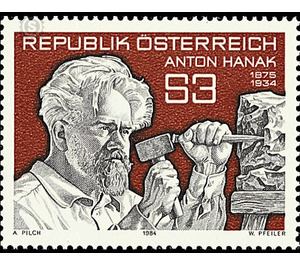50th anniversary of death - Austria / II. Republic of Austria 1984 - 3 Shilling
Theme: Well-known people
| Country | Austria / II. Republic of Austria |
| Issue Date | 1984 |
| Face Value | 3.00 |
| Color | black red |
| Printing Type | combination printing |
| Stamp Type | Commemorative |
| Item Type | Stamp |
| Chronological Issue Number | 1107 |
| Chronological Chapter | OOS-OE2 |
| SID | 581185 |
| In 72 Wishlists | |
The sculptor Anton Hanak was born on March 22, 1875 in Brno. He completed an apprenticeship with a carpenter and woodcarver, which he completed in 1893. After several years of wandering and practical testing of his skills, he joined in 1898 in the sculptor class Edmund Hellmers, the Academy of Fine Arts, which he visited until 1904. In 1906 he joined the Vienna Secession, where he made friends with, among others, the painter Gustav Klimt and the architect Josef Hoffmann. In 1910 he left this group of artists again. With the year 1911 began for Hanak a great time of success, among other things, he worked with Josef Hoffmannn's Austria Pavilion at the international art exhibition in 1911 in Rome. The larger than life tri-figured group of Austria ("Creative Power") and nine other sculptures integrated into the strict architecture made him internationally known for the first time. The outbreak of war and the subsequent demise of the old Danube monarchy shook Hanak hard. His works after the war express this desperation and disruption. In 1922, for example, he worked on "Burning Man", a self-portrayal of this difficult time. In 1932, much too late, Hanak was appointed professor of the Academy of Fine Arts in Vienna. Only two years later, on January 7, 1934, he died of a heart attack.


